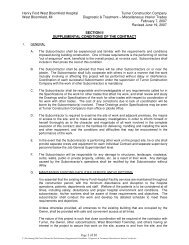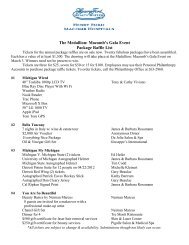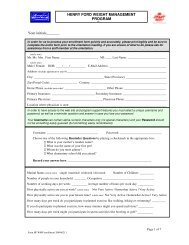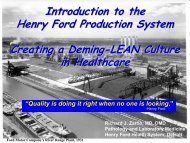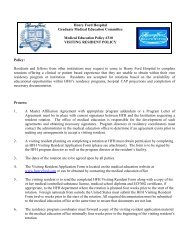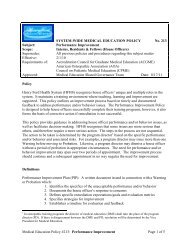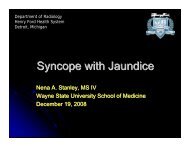Training
PowerPoint Presentation - No Slide Title - Henry Ford Health System
PowerPoint Presentation - No Slide Title - Henry Ford Health System
Create successful ePaper yourself
Turn your PDF publications into a flip-book with our unique Google optimized e-Paper software.
A3 Writing<br />
HFPS PDCA Road Map<br />
LEAN <strong>Training</strong> 2010<br />
Scientific Problem Solving<br />
Ruan C. Varney, CT, CQE, SSBB<br />
Henry Ford Health System<br />
Core of an improvement process<br />
Henry Ford Production System
Objectives<br />
LEAN <strong>Training</strong> 2010<br />
The Participants will be able to describe:<br />
‣ What is an A3?<br />
‣ A3 thinking process<br />
‣ A3 Report<br />
‣ Problem solve using PDCA cycles<br />
Exercise<br />
‣ A3 writing in groups<br />
‣ Presentation<br />
Henry Ford Production System
What is an A3?<br />
LEAN <strong>Training</strong> 2010<br />
‣ Problem-Solving like telling a story<br />
‣ Vital information- plan, data & solution<br />
‣ 11x 17 size<br />
‣ Communicated by fax<br />
‣ Visual communication tool<br />
‣ Team based problem solving using<br />
(Plan-Do-Check-Act) cycles<br />
Liker JK. The Toyota Way Field Böök: A Practical Guide for<br />
Implementing Toyota’s 4P’s. McGraw-Hill; 2006.<br />
Henry Ford Production System
A3 Thinking<br />
A3 Thinking<br />
Concept of an “Ideal” state<br />
‣ Exactly what customer<br />
needs<br />
The 4 Rules of work<br />
1. Activities: Work clearly defined -<br />
Content, Sequence, Timing &<br />
Outcome<br />
LEAN <strong>Training</strong> 2010<br />
‣ On demand- when, where<br />
needed<br />
‣ No waste, Defect Free<br />
‣ Safe for allcustomers<br />
& suppliers<br />
Lee & Woll “Reflections on the Idealized<br />
Design Planning Process” CQM Journal,<br />
Spring 2003<br />
2. Connections: The “Hand off”<br />
between customer & supplier,<br />
no ambiguity -Yes/No answer<br />
3. Pathways: Information flow -<br />
Simple & Direct<br />
4. Improvement: Made using PDCA<br />
cycles, by those who do the work,<br />
in real time<br />
Spear & Bowen “Decoding the DNA of the<br />
Toyota Production System”<br />
Harvard Business Review 1999<br />
Henry Ford Production System
Core of an Improvement Process<br />
Core of an Improvement Process<br />
Shewhart or Deming cycle<br />
Study results<br />
What did we learn?<br />
Plan<br />
What change is<br />
needed?<br />
What data is<br />
needed?<br />
LEAN <strong>Training</strong> 2010<br />
Act<br />
Observe the effects<br />
of the pilot<br />
Never ending<br />
Repeat: Plan,Do.. ..<br />
Check<br />
Do<br />
Carryout the<br />
change<br />
Pilot the decision<br />
Henry Ford Production System
A3 Report A3 Report<br />
Plan<br />
Reason for Improvement<br />
Define the problem clearly & narrow down issue<br />
Consider customer’s need<br />
Do-Check-Act<br />
Counter Measure<br />
Implement the agreed countermeasures that will<br />
correct the root cause of the problem<br />
LEAN <strong>Training</strong> 2010<br />
Current Condition<br />
Collect data & analyze using Pareto charts,<br />
histograms<br />
Identify themes & customer requirements<br />
Write a clear & concise problem statement<br />
Problem Analysis<br />
Identify root cause of problem<br />
5 “why’s”, cause & effect diagrams<br />
Target Condition<br />
Develop measurable target for the problem<br />
Develop & agree on potential countermeasures<br />
Action Plan<br />
Details of new plan or intervention to reach the<br />
target<br />
Way things happen now<br />
“Current state or the problem”<br />
Implementation Plan<br />
Roll out the action plan with Who/<br />
When/What/Where & How<br />
Results<br />
Confirm effectiveness<br />
Compare data with problem “before” and “after”<br />
using same indicators<br />
Standardization<br />
Assure that countermeasure is a part of daily work<br />
Create or revise the process if necessary<br />
Train & assign responsibility to monitor<br />
Future Plans<br />
Analyze & evaluate the remaining problems<br />
Review lessons learned<br />
What could be improved? Done differently?<br />
The better way of work<br />
“Ideal state or solution”<br />
Henry Ford Production System
Reason for Improvement<br />
PLAN<br />
LEAN <strong>Training</strong> 2010<br />
‣ Define the problem clearly &<br />
narrow down the issue<br />
‣ Identify the reason for working on it<br />
Activity<br />
• Survey internal/external customers<br />
• Interview staff<br />
• Consider customer needs<br />
Example<br />
• Transportation of lymphoma specimens from Radiology to<br />
Surgical Pathology (3-6th floor) is taking 4-5 hrs<br />
• Requirement: Tissue must reach SP within 2 hrs of obtaining<br />
Henry Ford Production System
Current Condition<br />
Current Condition<br />
PLAN<br />
‣ Collect data on all aspects of problem<br />
‣ Analyze & prioritize<br />
LEAN <strong>Training</strong> 2010<br />
Activity<br />
• Use Pareto charts, cause & effect diagrams<br />
• Identify customer’s requirements<br />
• Write a clear problem statement<br />
• Use data to establish the target<br />
Henry Ford Production System
Gross Room<br />
Refrigerator<br />
Elevator<br />
Laboratory 6 th Floor<br />
Example<br />
Accessioning<br />
Specimen Drop‐Off<br />
Window<br />
Hematology<br />
LEAN <strong>Training</strong> Lab 2010<br />
Refrigerator<br />
Main Elevator 6th Floor<br />
Surgical Pathology<br />
Pick‐up Rack<br />
Current State Specimen Delivery Path<br />
Chemistry Lab 6 th Floor<br />
= Radiology Tech =Chemistry Lab Tech<br />
= Pathologist = Accession Tech<br />
Radiology<br />
Specimen Drop Off<br />
Window<br />
HLA Lab<br />
Henry Ford Production System
Time taken to travel from Radiology to Surgical Pathology<br />
Time taken to travel between Radilogy & Surgical Pathology<br />
Time Length<br />
H:M:S<br />
10:00:00<br />
5 month study-<br />
45% delayed over 2 hrs<br />
45% Over<br />
Two Hours<br />
8:00:00<br />
6:00:00<br />
Elapsed Time<br />
4:00:00<br />
2:00:00<br />
0:00:00<br />
LEAN <strong>Training</strong> 2010<br />
5/29/09 9:45 AM<br />
6/1/09 9:59 AM<br />
6/8/09 12:20 PM<br />
6/12/09 10:35 AM<br />
8/11/09 8:40 AM<br />
8/11/09 9:30 AM<br />
8/11/09 9:50 AM<br />
8/24/09 2:14 PM<br />
8/25/09 8:45 AM<br />
8/25/09 12:45 PM<br />
8/27/09 8:11 AM<br />
8/31/09 11:11 AM<br />
9/3/09 9:19 AM<br />
9/10/09 8:00 AM<br />
9/16/09 4:53 PM<br />
10/2/09 10:49 AM<br />
10/6/09 11:58 AM<br />
10/9/09 7:55 AM<br />
10/9/09 9:32 AM<br />
10/15/09 7:54 AM<br />
Procedure Date and Time<br />
Average<br />
Henry Ford Production System
Problem Analysis<br />
Problem Analysis<br />
LEAN <strong>Training</strong> 2010<br />
PLAN<br />
‣ Identify and verify the root cause<br />
of the problem<br />
‣ Select RC with probable greatest impact<br />
Activity<br />
• Ask 5 “why’s”<br />
• Perform cause and effect analysis<br />
Example<br />
Why are the spec. not transported on time? No one knew it had to be<br />
Why does no one know? Not identified as “Rush” or communicated<br />
Why not communicated or identified? No existing process in place<br />
Why no process? We’ve always done it this way<br />
RCA- A) Identifiable as “Rush” B) Need a standardized process<br />
Henry Ford Production System
Target Condition<br />
Target Condition<br />
LEAN <strong>Training</strong> 2010<br />
PLAN<br />
‣ Develop & agree on measurable target for<br />
problem – (activity of improvement not perfection)<br />
‣ Agree on potential countermeasures<br />
Activity<br />
• Meet customer’s valid requirement<br />
• Select root causes with probable greatest impact<br />
Example<br />
• Meet surgical pathology (customer’s) requirement 100% of the time<br />
for all lymphoma specimens<br />
Henry Ford Production System
Defining the Target Condition<br />
Ideal state<br />
LEAN <strong>Training</strong> 2010<br />
PLAN Do-Check-Act<br />
Current condition<br />
Target condition<br />
Henry Ford Production System
Action Plan Action Plan<br />
PLAN<br />
‣ Develop the new plan & reach consensus<br />
‣ Evaluate countermeasures<br />
LEAN <strong>Training</strong> 2010<br />
Activity<br />
• Is the plan doable? Does it make sense?<br />
• Consider up & downstream effects<br />
• Reach consensus from customers & suppliers<br />
Example<br />
• - Identify the specimens by a visual sticker<br />
• - Transport specimens directly to SP –direct hand off<br />
Henry Ford Production System
2<br />
LEAN <strong>Training</strong> 2010<br />
Henry Ford Production System<br />
Direct Hand off From<br />
Radiology to Surg. Path<br />
1<br />
Visuals<br />
Aid<br />
Visuals<br />
Specimen Identified with<br />
Bright Yellow Stickers
Countermeasures<br />
DO<br />
‣ Implement the agreed countermeasures<br />
LEAN <strong>Training</strong> 2010<br />
Activity<br />
• Evaluate – does it make sense?<br />
• Is it doable?<br />
Example<br />
• Chain of custody<br />
• Trackable<br />
Henry Ford Production System
Implementation Plan<br />
Implementation Plan<br />
DO<br />
‣ Roll out the action plan<br />
LEAN <strong>Training</strong> 2010<br />
Activity<br />
• Answers who, what, when & where<br />
• Educate all involved of the expected outcome<br />
Example<br />
Specific Task Who By When Date Completed<br />
Education/Track Team leader- SP Immediately 1 week<br />
Henry Ford Production System
Results Results & Metrics<br />
CHECK<br />
‣ Confirm that the problem has decreased<br />
& the target has been met<br />
LEAN <strong>Training</strong> 2010<br />
Activity<br />
• Collect data before and after using same indicator<br />
• Implement additional countermeasures if needed<br />
Example<br />
• Happy customers & suppliers<br />
Henry Ford Production System
Results<br />
Legend:<br />
=Terminator<br />
=Process<br />
=Predefined Process<br />
=Decision<br />
=Lymphoma Bx<br />
Cat Scan (CT)<br />
(3rd floor)<br />
CS<br />
Radiology<br />
Ultra Sound<br />
or<br />
Cat Scan<br />
US<br />
Ultra Sound<br />
(US)<br />
Example<br />
LEAN <strong>Training</strong> 2010<br />
•Eliminated<br />
unnecessary<br />
Motion<br />
•Eliminated<br />
waiting<br />
Chemistry<br />
Cyto<br />
STAT?<br />
No<br />
Clinician Procedure<br />
(Bx,fluids,needles)<br />
No<br />
Tech. Assistant Transports<br />
to Core STAT Lab Drop Off<br />
(Delivery times not<br />
specified)<br />
Micro<br />
Yes<br />
Surgical<br />
Path<br />
Clinician Notifies<br />
Tech Assistant/<br />
Initiate STAT<br />
Clinician Procedure<br />
(Bx,fluids,needles)<br />
Tech Assistant<br />
Apply STAT Label<br />
Tech Assistant<br />
Transports Lymph<br />
Node to Surg Path<br />
ASAP<br />
Sign-off<br />
Sign-off<br />
Sign-off<br />
Sign-Off<br />
Henry Ford Production System
Standardization<br />
ACT<br />
‣ Prevent the problem and its root cause<br />
from re-occurring<br />
LEAN <strong>Training</strong> 2010<br />
Activity<br />
• Assure the changes become part of the daily<br />
work<br />
• Revise and/or post work/standards<br />
• Train employees on the new process<br />
• Assign responsibility to monitor results<br />
Henry Ford Production System
Future Plans<br />
Future Plans<br />
LEAN <strong>Training</strong> 2010<br />
‣ Analyze & evaluate the remaining<br />
problems<br />
‣ Review lessons learned –Improved?<br />
Done differently?<br />
Never ending<br />
Henry Ford Production System
Breakout- A3 Writing<br />
Breakout- A3 Writing<br />
LEAN <strong>Training</strong> 2010<br />
‣ Topic choice:<br />
1. Defect identified- Waste Walk<br />
2. Defect/situation from your own work place<br />
In your groups<br />
• Develop a detailed A3 Report<br />
• Appoint a group leader<br />
• Present your A3 story<br />
Henry Ford Production System
Take Home Lessons<br />
Take Home Lessons<br />
LEAN <strong>Training</strong> 2010<br />
‣ Brainstorm plan & solutions<br />
‣ Involve all customers & suppliers to solve problem<br />
‣ Investigate root causes to develop<br />
countermeasures<br />
‣ Communicate & assign responsibility to sustain<br />
results<br />
‣ Empower staff to continuously improve & reach<br />
for the “ideal” state<br />
‣ Suggested: use one A3 report per problem<br />
Henry Ford Production System
Don’t Get Frustrated!<br />
LEAN <strong>Training</strong> 2010<br />
Q & A ?<br />
Henry Ford Production System




